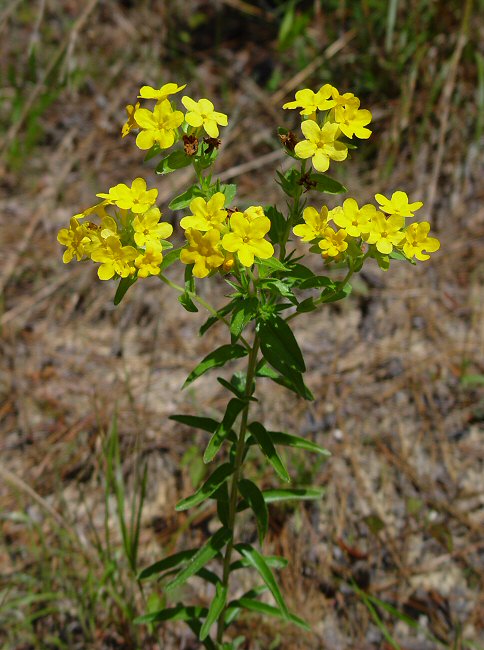Lithospermum caroliniense (J.F. Gmel.) MacMill.
Plains Puccoon

Native
CC = 7
CW = 5
MOC = 7
© DETenaglia
Lithospermum caroliniense (J.F. Gmel.) MacMill.Plains Puccoon | |
 |
Native CC = 7 CW = 5 MOC = 7 |
© DETenaglia |
|
Family - Boraginaceae Habit - Perennial forb with a stout, woody taproot or occasionally short rhizomes. Stems - Ascending to erect, to 60 cm, usually a few to several, unbranched or more commonly sparsely branched toward the tip, roughened-pubescent with moderate to dense, short, fine, loosely ascending but stiff hairs and sparse to moderate longer, stouter hairs, both kinds minutely pustular-based.
Leaves - Alternate, simple, sessile. Stem leaves 2-6 cm long, 3-12 mm wide, linear to narrowly oblong or lanceolate, relatively thick, angled to narrowly rounded at the base, rounded or angled to a usually bluntly pointed tip, sometimes with a mucro, the surfaces moderately to densely pubescent with short, stiff, loosely ascending, pustular-based hairs, grayish green to green, without noticeable lateral veins.
Inflorescences - Dense terminal clusters, these subsequently elongating into ascending, scorpioid, spikelike racemes 5-25 cm long.
Flowers - Perfect, heterostylous. Calyces 7-12 mm long at flowering, elongating to 10-18 mm at fruiting, hairy. Corollas actinomorphic, broadly funnelform, 14-25 mm long, yellow to orange, the tube 7-14 mm long, the lobes 5-8 mm long, entire. Stamens attached near the tip of the corolla tube in long-styled flowers, near the midpoint in short-styled flowers. Ovary deeply 4-lobed, the styles 5-12 mm long in long-styled flowers, 2-5 mm long in short-styled flowers, not or rarely slightly exserted from the corolla, often not persistent at fruiting, the stigma capitate, 2-lobed. Cleistogamous flowers absent.
Fruits - Schizocarps dividing into 4 nutlets, these 3-4 mm long, the tip more or less symmetrical, without an appendage at the attachment point, smooth, white to ivory-colored. Flowering - April - June. Habitat - Sand prairies, upland prairies, roadsides, railroads, open sandy areas. Origin - Native to U.S. Lookalikes - L. canescens. Other info. - This brilliant species is found in only a few widely scattered counties in Missouri where its sandy habitat occurs. Within the continental U.S. its distribution is patchy and somewhat scattered, but mainly confined to the central portion of the country. Plants in the genus are easily recognized on general appearances. This species can be distinguished from its close lookalike, the more common L. canescens, by its rough-pustular pubescent leaves and larger calyces and corollas. The corolla lobes have entire margins, unlike the fringed lobes of L. incisum. Photographs taken at Fort Benning, GA., 5-6-05 (DETenaglia); also at Holly Ridge Conservation Area, Stoddard County, MO, 5-20-2014, and near Halsey, Thomas County, NE, 6-9-2015 (SRTurner). |